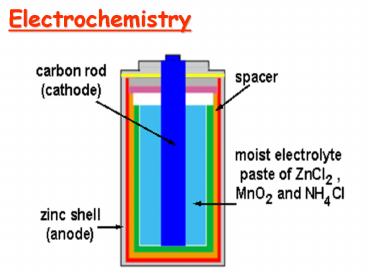Electrochemistry - PowerPoint PPT Presentation
1 / 24
Title:
Electrochemistry
Description:
Title: CB South AP Chem Chapter 20 ppt Author: Helena Buzin Last modified by: Art Buzin Created Date: 5/11/2006 4:34:36 PM Document presentation format – PowerPoint PPT presentation
Number of Views:561
Avg rating:3.0/5.0
Title: Electrochemistry
1
Electrochemistry
2
Electrochemistry Terminology 1
- Oxidation A process in which an element attains
a more positive oxidation state - Na(s) ? Na e-
- Reduction A process in which an element attains
a more negative oxidation state - Cl2 2e- ? 2Cl-
3
Electrochemistry Terminology 2
An old memory device for oxidation and reduction
goes like this
LEO says GER
Lose Electrons Oxidation
Gain Electrons Reduction
4
Electrochemistry Terminology 3
- Oxidizing agent
- The substance that is reduced is the oxidizing
agent - Reducing agent
- The substance that is oxidized is the reducing
agent
5
Electrochemistry Terminology 4
- Anode
- The electrode where oxidation occurs
- Cathode
- The electrode where reduction occurs
Memory device
Reduction at the Cathode
6
Table of Reduction Potentials
Measured against the StandardHydrogenElectro
de
7
Measuring Standard Electrode Potential
Potentials are measured against a hydrogen ion
reduction reaction, which is arbitrarily assigned
a potential of zero volts.
8
Galvanic (Electrochemical) Cells
- Spontaneous redox processes have
A positive cell potential, E0
A negative free energy change, (-?G)
9
Zn - Cu Galvanic Cell
From a table of reduction potentials
- Zn2 2e- ? Zn E -0.76V
- Cu2 2e- ? Cu E 0.34V
10
Zn - Cu Galvanic Cell
The less positive, or more negative reduction
potential becomes the oxidation
- Cu2 2e- ? Cu E 0.34V
Zn ? Zn2 2e- E 0.76V
Zn Cu2 ? Zn2 Cu E0 1.10 V
11
Line Notation
An abbreviated representation of an
electrochemical cell
Zn(s) Zn2(aq) Cu2(aq) Cu(s)
Anode material
Cathode material
Anode solution
Cathode solution
12
Calculating ?G0 for a Cell
?G0 -nFE0
n moles of electrons in balanced redox equation
F Faraday constant 96,485 coulombs/mol e-
Zn Cu2 ? Zn2 Cu E0 1.10 V
13
The Nernst Equation
Standard potentials assume a concentration of 1
M. The Nernst equation allows us to calculate
potential when the two cells are not 1.0 M.
R 8.31 J/(mol?K)
T Temperature in K
n moles of electrons in balanced redox equation
F Faraday constant 96,485 coulombs/mol e-
14
Nernst Equation Simplified
At 25 ?C (298 K) the Nernst Equation is
simplified this way
15
Equilibrium Constants and Cell Potential
At equilibrium, forward and reverse reactions
occur at equal rates, therefore
- The battery is dead
- The cell potential, E, is zero volts
Modifying the Nernst Equation (at 25 ?C)
16
Calculating an Equilibrium Constant from a Cell
Potential
Zn Cu2 ? Zn2 Cu E0 1.10 V
17
Concentration Cell
???
Both sides have the same components but at
different concentrations.
Step 1 Determine which side undergoes oxidation,
and which side undergoes reduction.
18
Concentration Cell
???
Both sides have the same components but at
different concentrations.
Anode
Cathode
The 1.0 M Zn2 must decrease in concentration,
and the 0.10 M Zn2 must increase in concentration
Zn2 (1.0M) 2e- ? Zn (reduction)
Zn ? Zn2 (0.10M) 2e- (oxidation)
Zn2 (1.0M) ? Zn2 (0.10M)
19
Concentration Cell
Concentration Cell
???
Both sides have the same components but at
different concentrations.
Anode
Cathode
Step 2 Calculate cell potential using the Nernst
Equation (assuming 25 ?C).
Zn2 (1.0M) ? Zn2 (0.10M)
20
Nernst Calculations
Zn2 (1.0M) ? Zn2 (0.10M)
21
Electrolytic Processes
Electrolytic processes are NOT spontaneous. They
have
A negative cell potential, (-E0)
A positive free energy change, (?G)
22
Electrolysis of Water
In acidic solution
Anode rxn
-1.23 V
Cathode rxn
-0.83 V
-2.06 V
23
Electroplating of Silver
Anode reaction
Ag ? Ag e-
Cathode reaction
Ag e- ? Ag
Electroplating requirements
1. Solution of the plating metal
2. Anode made of the plating metal
3. Cathode with the object to be plated
4. Source of current
24
Solving an Electroplating Problem
Q How many seconds will it take to plate out 5.0
grams of silver from a solution of AgNO3 using a
20.0 Ampere current?
Ag e- ? Ag
5.0 g
1 mol Ag
1 mol e-
96 485 C
1 s
20.0 C
1 mol e-
107.87 g
1 mol Ag
2.2 x 102 s































